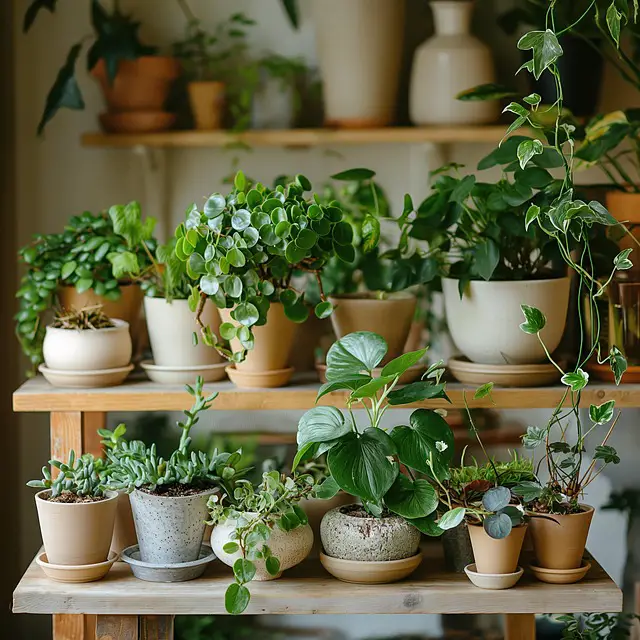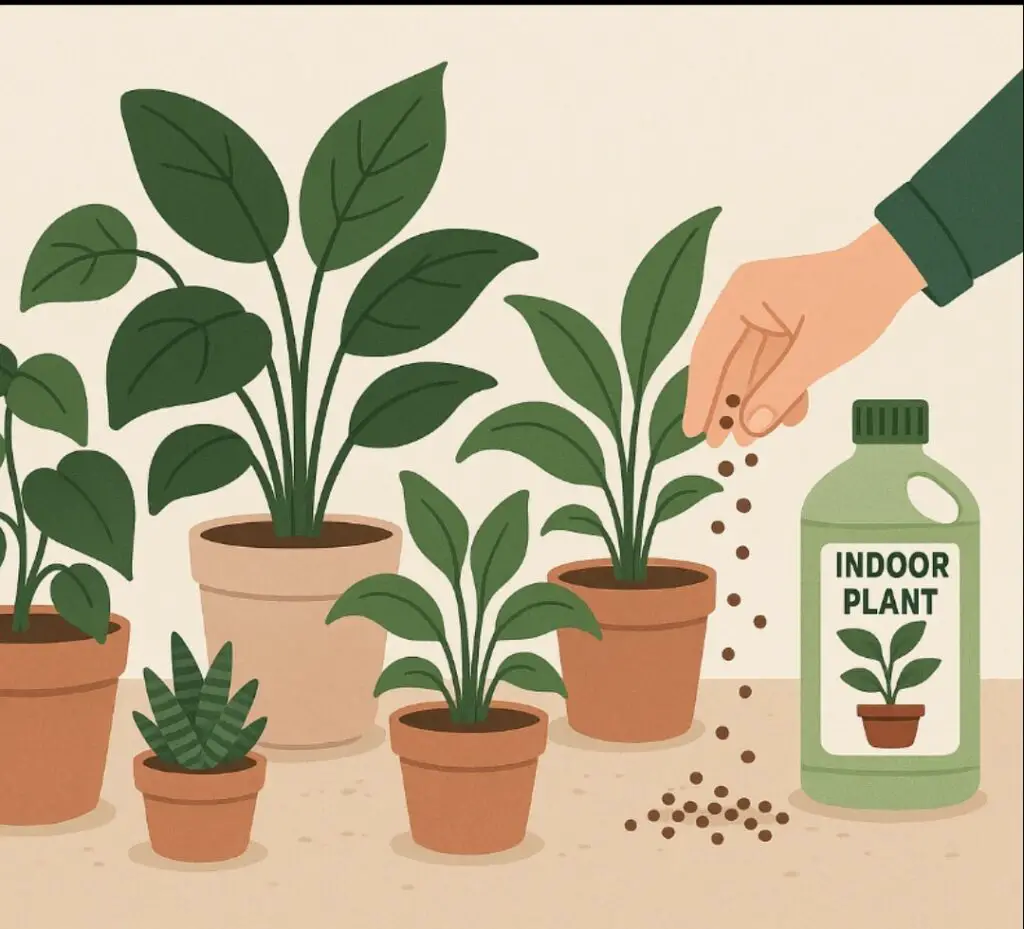
Indoor plants do much more than decorate your home — they purify the air, lift your mood, and bring a peaceful energy into your space.However, for plants to become robust and healthy, they require the same kind of nutrients as people.And that’s where indoor plant fertilizer plays a powerful role. When used correctly, fertilizer boosts foliage, encourages blooming, and strengthens root systems. But used incorrectly? It can damage or even kill your plant.
In this guide, we’ll uncover the 10 best powerful dos and don’ts when fertilizing indoor plants. Whether you’re a first-time plant parent or have years of experience, these tips will help you avoid common mistakes and unlock your plants‘ full potential.

- 1 Indoor Plant Fertilizer
- 2 ✅ 1. Do: Choose the Right Fertilizer for the Right Plant
- 3 ❌ 2. Don’t: Over-fertilize Thinking It Helps Growth
- 4 ✅ 3. Do: Fertilize Only During Active Growth Periods
- 5 ❌ 4. Don’t: Fertilize Dry Soil
- 6 ✅ 5. Do: Use Organic Fertilizer for Edible Indoor Plants
- 7 ❌ 6. Avoid forgetting to flush the soil once a month.
- 8 ✅ 7. Do: Use Slow-Release Fertilizer for Busy Schedules
- 9 ❌ 8. Don’t: Use Outdoor Fertilizer Indoors
- 10 ✅ 9. Do: Observe and Adjust Based on Plant Response
- 11 ❌ 10. Don’t: Ignore the NPK Ratio on the Label
- 12 🕒 Indoor Plant Fertilizer Schedule (At a Glance)
- 13 🌿 Final Thoughts
Indoor Plant Fertilizer
Feature. Details
Purpose. Feeds plants essential nutrients
Type. Liquid, slow-release, organic, etc.
Best For. Indoor houseplants, herbs, orchids
Frequency. Every 2-4 weeks (varies per plant)
Application Method. Watering can, spray, soil mix
✅ 1. Do: Choose the Right Fertilizer for the Right Plant
Not all fertilizers are created equal. Every plant has different nutritional needs, and using the wrong fertilizer can be ineffective — or worse, harmful. For example, flowering plants like African violets need more phosphorus to support blooms, while leafy houseplants like pothos or monstera benefit from a nitrogen-rich formula to encourage lush, green growth. Succulents and cacti, on the other hand, require very low nitrogen and a different mineral balance altogether.
💡 Tip: Always read the plant label or research your plant type before choosing a fertilizer. A balanced 10-10-10 or 20-20-20 fertilizer is safe for general indoor plant care.
❌ 2. Don’t: Over-fertilize Thinking It Helps Growth
This is one of the most common mistakes among new plant lovers. It’s easy to think that feeding your plants more often will make them grow faster or healthier. Regretfully, there is nothing more false than this.Over-fertilizing leads to nutrient burn, root damage, yellowing leaves, salt buildup in the soil, and even plant death in extreme cases.
⚠️ Rule of thumb: Less is more.For sensitive plants, start with half the suggested dosage. Only increase if the plant exhibits pale leaves or poor development.
✅ 3. Do: Fertilize Only During Active Growth Periods
. Like outdoor plants, indoor plants have a natural rhythm. The majority slow down in the fall and winter after entering a growth phase in the warmer months of spring and summer.Fertilizing during active growth gives your plant a helpful boost when it’s putting out new leaves, roots, or blooms. But during dormant months, the nutrients won’t be used, and feeding can cause stress or buildup.
📅 Plan ahead: Begin feeding around March when days get longer, and stop by October unless the plant is still actively growing under grow lights.
❌ 4. Don’t: Fertilize Dry Soil
One of the biggest fertilizer mistakes you can make is applying it to dry soil. This is like giving an athlete energy drinks when they’re dehydrated — it shocks the system. Dry roots absorb nutrients too quickly, increasing the risk of root burn, which shows up as brown leaf tips or crispy edges.
💧 Care Tip: Always water your plant first. Let the soil become slightly moist, then apply fertilizer on top. This helps nutrients absorb evenly and safely.
✅ 5. Do: Use Organic Fertilizer for Edible Indoor Plants
If you’re growing herbs, microgreens, or vegetables indoors — like mint, basil, or cherry tomatoes — it’s crucial to use organic or natural fertilizers. These are free from harmful chemicals and safe for food-producing plants. They not only support healthy growth but also improve soil quality over time, leading to better flavor and more harvests.
🌿 Try this: For little indoor edible gardens, compost tea, liquid seaweed, or worm castings are excellent options. They are eco-friendly, gentle, and effective.
❌ 6. Avoid forgetting to flush the soil once a month.
Even when you fertilize correctly, salts and mineral residues can slowly build up in your plant’s soil over time. This buildup can eventually affect nutrient absorption and cause problems like leaf tip burn or stunted growth. Many people don’t realize this silent issue is slowly damaging their plant.
🚿 Fix it fast: Once a month, run clean, lukewarm water through the pot for a few minutes to rinse away excess salts. Make sure the pot has proper drainage!
✅ 7. Do: Use Slow-Release Fertilizer for Busy Schedules
If you often forget your feeding routine or want a low-maintenance solution, slow-release fertilizers are a game-changer. These come in the form of pellets, spikes, or capsules that break down gradually over several weeks, giving your plant consistent nutrition without constant attention.
🕒 Perfect for: Office plants, rental homes, or travelers. Just one application can feed a plant for up to 3 months!
❌ 8. Don’t: Use Outdoor Fertilizer Indoors
Outdoor plant fertilizers are usually too concentrated for indoor plants and can contain additives that aren’t safe for use in enclosed spaces. Using them indoors can lead to strong odors, pest issues, or even harmful chemical buildup.
🏠 Stay safe: Always choose fertilizers specifically labeled “safe for indoor plants.” These are typically more diluted and formulated for smaller pots and less airflow.
✅ 9. Do: Observe and Adjust Based on Plant Response
Plants don’t speak, but they do show signs when they’re happy or stressed. Yellowing leaves, curling tips, or slow growth can be signs of underfeeding. Meanwhile, browning tips, wilting, or a white crust on the soil might mean overfeeding. Every plant is different, and factors like pot size, light, and humidity affect how much food it needs.
👀 Check regularly: Inspect your plants every week. If they’re growing well and look healthy, your routine is working. If not, adjust slowly.
❌ 10. Don’t: Ignore the NPK Ratio on the Label
Every fertilizer label includes three numbers, like 10-10-10 or 3-1-2.The letters N-P-K stand for nitrogen (N), phosphorus (P), and Potassium (K). Each nutrient serves a specific purpose:
Nitrogen (N) helps leaf and stem growth.
Phosphorus (P) supports root development and blooming.
Potassium (K) improves overall health and resistance to disease.
📦 Pro tip: Increase the amount of nitrogen in leafy plants. Select a bloom booster with higher phosphorus content for flowering plants.
🕒 Indoor Plant Fertilizer Schedule (At a Glance)
Season Frequency Best Type
Spring Every 2–3 weeks Balanced liquid or organic
Summer Every 2 weeks Liquid, compost tea
Fall Monthly or reduce Light feeding, if any
Winter Rarely or only if needed Only if under grow lights
🌿 Final Thoughts
Fertilizing indoor plants isn’t about doing more — it’s about doing it right. The key is knowing your plant, reading the signs, and creating a consistent but gentle care routine. These 10 best powerful dos and don’ts will guide you in giving your plants exactly what they need — no more, no less. With just a little attention, your houseplants will reward you with vibrant leaves, strong roots, and maybe even a few surprise blooms.







